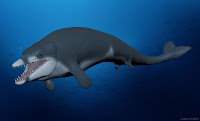 |
| Tutcetus rayanensis Antar, Gohar, El-Desouky, Seiffert, El-Sayed, Claxton & Sallam, 2023 Artwork: Ahmed Morsi |
Abstract
Soon after whales originated from small terrestrial artiodactyl ancestors, basal stem forms (archaeocetes) came to inhabit more specialized aquatic ecologies and underwent a tremendous adaptive radiation that culminated in the adoption of a fully aquatic lifestyle. This adaptive strategy is first documented by the geographically widespread extinct family Basilosauridae. Here we report a new basilosaurid genus and species, Tutcetus rayanensis, from the middle Eocene of Fayum, Egypt. This new whale is not only the smallest known basilosaurid, but it is also one of the oldest records of this family from Africa. Tutcetus allows us to further test hypotheses regarding basilosaurids’ early success in the aquatic ecosystem, which lasted into the latest Eocene, and their ability to outcompete amphibious stem whales and opportunistically adapt to new niches after they completely severed their ties to the land. Tutcetus also significantly expands the size range of the basilosaurids and reveals new details about their life histories, phylogeny, and paleobiogeography.
Systematic paleontology
Mammalia Linnaeus, 1758
Cetacea Brisson, 1762
Pelagiceti Uhen, 2008
Basilosauridae Cope, 1868
Tutcetus, new genus
Etymology: A combination of Tut, for the ancient Egyptian Pharoah Tutankhamun, commonly known as King Tut, who unexpectedly died in his 18th year, and cetus, Greek for a whale. Genus name is used in reference to the subadult status and the diminutive size of the type specimen.
Type species: Tutcetus rayanensis, new genus and species.
Generic diagnosis: The specimen was assigned to the family Basilosauridae based on the presence of multiple accessory cusps on the cheek teeth and well-developed pterygoid sinuses around the auditory region. Tutcetus rayanensis differs from other basilosaurids by its diminutive size (possibly the smallest known basilosaurid); it further differs in having a maxilla that abuts most of the lateral sides of the nasal, leaving only a small anterior portion of the nasal to articulate with the ascending process of the premaxilla; the number of mesial and distal accessory cusps on the upper and lower premolars (mainly two mesially and three distally). Furthermore, the premolars of Tutcetus rayanensis are more gracile than those of any other known basilosaurid and have extremely smooth enamel, and the fourth premolar (P44) is the largest tooth in both the upper and lower jaws. Tutcetus rayanensis lacks replacement of the first premolar. The Supplementary Information provides a more detailed diagnosis (Supplementary Note 1).
Tutcetus rayanensis, new species
Etymology: A combination of “Rayan,” in reference to the Wadi El-Rayan Area, the locality of the holotype, and “-ensis” (Gr., N.L. masc. adj.).
Mohammed S. Antar, Abdullah S. Gohar, Heba El-Desouky, Erik R. Seiffert, Sanaa El-Sayed, Alexander G. Claxton and Hesham M. Sallam. 2023. A diminutive New basilosaurid Whale reveals the Trajectory of the Cetacean Life Histories during the Eocene. Communications Biology. 6: 707. DOI: 10.1038/s42003-023-04986-w





